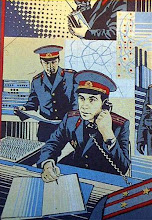
Dogme 95 - Another influence of the Manifesto!!! was the Danish film manifesto put forth by director Lars von Trier, Dogme 95. Dogme 95's ideals, which are put forth in a set of 10 rules, attempts to rid film of the more commercialized aspects of filmaking and the elements that come with it, i.e. expensive special effects, postproduction editing, and other constraints. In doing so, Dogme 95 attempts to "purify" cinema. However, Remodernist film would go on to reject Dogme 95.
Futurism - Futurism was an Italian art movement in the early 20th century that displayed a rejection of all old forms of art, politics, and lifestyles, instead concerning themselves with the new, the modern, the exciting, and the urban. They also called for a unity in arts, ranging from painting to music to dance, among others. Interested as we are in their aesthetic, the Futurist's ideas supported fascist governments, showed rampant nationalism, and "glorified war". For this, we disagree with the central tenets of the movement, but found them worth mentioning for the next item we will mention:
Musica Futurista - Born from Futurism was Futurist music, and from this came a book called The Art of Noises by one Luigi Russolo. In this book Russolo argued that in the modern age, man's ear had grown accustomed the constant noise produced by the industrial, urban landscape, and because of this musicians had to find new ways to to approach music, mainly through means of electronic and other technological innovations. He broke the Futurist orchestra down into six families of noises:
- Roars, Thunderings, Explosions, Hissing roars, Bangs, Booms
- Whistling, Hissing, Puffing
- Whispers, Murmurs, Mumbling, Muttering, Gurgling
- Screeching, Creaking, Rustling, Humming, Crackling, Rubbing
- Noises obtained by beating on metals, woods, skins, stones, pottery, etc.
- Voices of animals and people, Shouts, Screams, Shrieks, Wails, Hoots, Howls, Death rattles, Sobs
The ideas of Russolo and The Art of Noises would later impact John Cage, Karlheinz Stockhausen, and the Fluxus movement.
The Happening - The central concept of the Manifesto!!! is that of the happening, which is an event or gathering that could be considered art. The Happening would usually have key elements of the event planned, but there would be room for improvisation . Many of the early Happenings involved performance art put forth by the Fluxus artists, and it's relevance to us is our dream to see the unification of various forms of art. Music can be aided by films, the music drives people to dance, or paint, to make music of their own, or to sculpt or write or whatever other form of expression they so chose to partake in. And all can be used as a vehicle to inspire real social change.
The Happening - The central concept of the Manifesto!!! is that of the happening, which is an event or gathering that could be considered art. The Happening would usually have key elements of the event planned, but there would be room for improvisation . Many of the early Happenings involved performance art put forth by the Fluxus artists, and it's relevance to us is our dream to see the unification of various forms of art. Music can be aided by films, the music drives people to dance, or paint, to make music of their own, or to sculpt or write or whatever other form of expression they so chose to partake in. And all can be used as a vehicle to inspire real social change.





